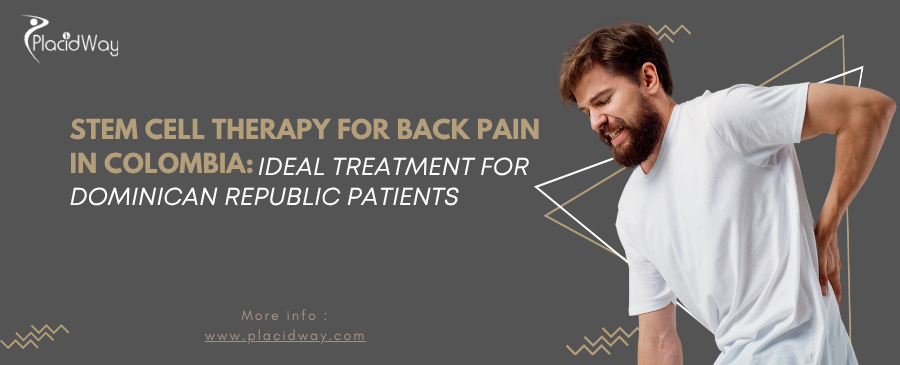Stem cell therapy for back pain in Colombia offers an advanced regenerative treatment, often at a fraction of the cost in the US. This guide covers the procedures, costs, and top clinics for this innovative solution to chronic pain.
Are you tired of chronic back pain controlling your life? If traditional treatments like physical therapy, injections, or even surgery haven’t provided lasting relief, you might be looking for other options. That’s where stem cell therapy for back pain in Colombia comes in. This innovative field of regenerative medicine is gaining huge momentum, and Colombia, particularly cities like Medellín and Bogotá, has become a world-class destination for high-quality, affordable care.
So, what’s it all about? In simple terms, stem cell therapy uses your body’s own repair mechanisms—or cells from a screened donor—to help heal damaged tissues, like the discs or joints in your spine. Instead of just masking symptoms, the goal is to repair the underlying problem, reduce inflammation, and get you back to living a life with less pain. It’s a minimally invasive alternative that’s helping people avoid major spinal surgery.
We know you have a lot of questions. Is it safe? Does it actually work? And, of course, how much does it cost? In this guide, we’ll answer all the important questions people are asking about getting stem cell therapy for their back pain in Colombia, giving you the clear, expert information you need to make an informed decision.
What Is Stem Cell Therapy for Back Pain?
“Stem cell therapy for back pain is a minimally invasive procedure where stem cells are injected into the damaged area of the spine, such as a degenerated disc or arthritic facet joint, to promote tissue repair, reduce inflammation, and alleviate pain.”
Think of stem cells as your body’s “master cells.” They are undifferentiated, meaning they have the unique ability to transform into specialized cells (like cartilage, bone, or disc cells) and can also multiply. When you have a condition like degenerative disc disease or a herniated disc, the tissue is damaged and inflamed.
The therapy involves concentrating these powerful cells and injecting them precisely into the source of the pain using guidance (like ultrasound or fluoroscopy). Once there, they are thought to work in several ways:
- Reducing Inflammation: They release powerful anti-inflammatory proteins that can calm the chronic inflammation causing much of your pain.
- Signaling Other Cells: They act like signal callers, recruiting other repair cells from your body to the injured site to help with the healing process.
- Regeneration: In some cases, they may help regenerate damaged tissue, improving the structure and function of the spinal disc or joint over time.
Why Do People Travel to Colombia for This Treatment?
“People travel to Colombia for stem cell therapy due to its combination of significantly lower costs (often 50-70% less than in the US), high standards of medical care at internationally accredited clinics, and advanced regulatory framework that allows for treatments not yet widely available in other countries.”
Colombia has rapidly become a global leader in medical tourism, especially for regenerative medicine. The appeal isn’t just about price. Top clinics in Medellín, Bogotá, and Cali are equipped with state-of-the-art technology and staffed by highly trained, often US-educated, doctors.
The country’s health regulator, INVIMA (Instituto Nacional de Vigilancia de Medicamentos y Alimentos), has established clear guidelines for stem cell treatments. This regulation allows clinics to offer advanced cell therapies, such as high-dose allogeneic (donor) cells, that are still in clinical trials or unavailable in places like the United States. This combination of affordability, quality, and access to cutting-edge procedures makes it a compelling option for patients seeking alternatives to surgery.
How Much Does Stem Cell Therapy for Back Pain Cost in Colombia?
“The cost of stem cell therapy for back pain in Colombia typically ranges from $4,000 to $11,000 USD. More complex, high-dose treatments for severe conditions may cost up to $25,000, which is still significantly less than comparable treatments in the United States.”
This is one of the biggest motivators for patients. In the U.S., a single stem cell procedure for the back can easily cost $10,000 to $20,000 or more, and it’s almost never covered by insurance. The cost in Colombia is dramatically lower.
The final price depends on several factors:
- The Condition: Treating a single herniated disc will likely cost less than treating multi-level degenerative disc disease.
- Type of Cells: Autologous (your own cells) may have a different cost than allogeneic (donor cells).
- Number of Cells: The cell count (e.g., 50 million vs. 200 million cells) will impact the price.
- The Clinic: Reputation and the specific protocol offered will influence the final cost.
Here is a general cost comparison for stem cell therapy for orthopedic/back pain conditions:
Cost Comparison: Stem Cell Therapy (Orthopedic)
| Country | Average Price Range (USD) | Notes |
|---|---|---|
| Colombia | $4,000 – $11,000 | High-quality, advanced protocols. Excellent value. |
| United States | $10,000 – $25,000+ | Often restricted protocols and not covered by insurance. |
| Mexico | $5,000 – $15,000 | A popular option, but clinic quality can vary widely. |
| Europe (e.g., Germany) | $8,000 – $20,000 | High standards but also higher costs than Latin America. |
Is Stem Cell Therapy Legal and Regulated in Colombia?
“Yes, stem cell therapy is legal in Colombia and is regulated by the national health authority, INVIMA. This regulation ensures that clinics adhere to strict standards for cell processing, quality control, and patient safety.”
This is a critical point. Unlike some countries where “stem cell” clinics operate in a gray area, Colombia has a formal regulatory framework. This means that the leading clinics are held to a high standard. They must have certified labs (often GMP-certified, which is a global standard for manufacturing) to process the cells.
This regulation provides a layer of safety and confidence for international patients. You can and should ask any potential clinic for their INVIMA certifications and lab credentials.
What Types of Stem Cells Are Used for Back Pain in Colombia?
“Clinics in Colombia typically use mesenchymal stem cells (MSCs) for back pain. These are sourced either ‘autologously’ from the patient’s own bone marrow or fat tissue, or ‘allogeneically’ from ethically-sourced, lab-expanded umbilical cord tissue.”
Understanding the cell type is important. Mesenchymal stem cells (MSCs) are the “rockstars” of regenerative medicine for orthopedic conditions. They are ideal for healing musculoskeletal tissues like cartilage, bone, and ligaments.
- Autologous Cells (Your Own): These are harvested from your own body, usually from bone marrow (BMAC) or adipose (fat) tissue. The benefit is they are 100% your own cells. The drawback is that cell quality and quantity decline with age, and it requires an extra harvesting procedure.
- Allogeneic Cells (Donor): These are sourced from the umbilical cords of healthy, full-term births. The cells are rigorously screened for disease, expanded to very high, potent doses in a lab, and are cryogenically frozen. These cells are young, vibrant, and do not cause an immune reaction. This often allows for a much higher cell count to be used in the treatment.
Many top Colombian clinics prefer using allogeneic umbilical cord-derived MSCs because they can provide a consistent, high-potency, and high-dose treatment without needing a harvest procedure from the patient.
What Back Conditions Can Be Treated?
“Stem cell therapy in Colombia is commonly used to treat chronic back pain caused by degenerative disc disease, bulging or herniated discs, facet joint arthritis, and sacroiliac (SI) joint dysfunction.”
This therapy is targeted at conditions where tissue has degenerated or been damaged. It is not a cure-all, but it has shown promise for:
- Degenerative Disc Disease: Where discs lose hydration and shrink, causing pain. Stem cells may help re-hydrate the disc and reduce inflammation.
- Herniated or Bulging Discs: By reducing inflammation and potentially repairing the disc’s outer wall, stem cells can help alleviate the pain caused by the disc pressing on a nerve.
- Facet Joint Arthritis: Just like a knee, the small facet joints in your spine can get arthritis. Stem cells can be injected into these joints to function like a powerful anti-inflammatory and promote cartilage health.
- SI Joint Pain: This is a common source of “low back pain” that’s actually caused by the joint connecting your spine to your pelvis. Stem cells can be very effective for this joint.
Who Is a Good Candidate for This Therapy?
“A good candidate for stem cell therapy is someone with chronic back pain (lasting over 3 months) who has not found relief from conservative treatments like physical therapy or injections, and who wishes to avoid major spinal surgery.”
Ideal candidates are typically those who are in good overall health but suffer from a specific, diagnosed spinal condition. Your doctor or the clinic will need to review your MRIs and medical history to confirm you are a good fit.
You may not be a good candidate if you have an active infection, a history of certain cancers, or a bleeding disorder. It’s also not typically recommended for cases of severe spinal instability or advanced “bone-on-bone” collapse, where surgery might be the only viable option.
What Is the Procedure Like?
“The procedure is a minimally invasive, non-surgical treatment performed in an outpatient setting. Under local anesthesia, the doctor uses fluoroscopy (X-ray) or ultrasound guidance to inject the stem cell preparation directly into the targeted spinal discs or joints.”
The entire process is usually completed in a few hours. Here’s a step-by-step breakdown:
- Preparation: You will be made comfortable, and the injection area on your back will be cleaned and sterilized.
- Anesthesia: A local anesthetic is used to numb the skin and tissues, so you feel minimal discomfort. You are awake during the procedure.
- Guided Injection: This is the critical step. Using a fluoroscope (a live X-ray machine), the physician guides a needle to the exact target—whether it’s the center of a disc or a specific facet joint.
- Implantation: The prepared stem cell solution is slowly injected into the damaged site.
- Recovery: A small bandage is applied, and you will be monitored for a short period (usually 30-60 minutes) before being released to go back to your hotel and rest.
Is the Procedure Painful?
“Patients typically report minimal discomfort during the procedure. The area is numbed with local anesthetic, and while you may feel a ‘pressure’ sensation during the injection, it is generally not described as painful. Some soreness is common for a few days after.”
The most common feeling is a temporary increase in soreness or a “fullness” feeling in the back for 2-3 days post-procedure. This is a normal inflammatory response and is actually a sign that the body is starting its healing process. Clinics will provide pain medication for this short period if needed.
What Is the Recovery Time?
“Recovery is very fast. Most patients are advised to rest for a day or two and then can resume light activities and walking. You can typically fly home within 3-5 days. Strenuous activities and heavy lifting should be avoided for several weeks.”
This is a major advantage over surgery, which can have a recovery time of 6 months or more. The typical post-treatment protocol is:
- Day 1-3: Rest and relax. Short walks are encouraged. Avoid anti-inflammatory drugs (NSAIDs) like Ibuprofen, as they can interfere with the stem cell process.
- Day 4-7: You can usually travel home. Continue to take it easy.
- Week 2-6: You can gradually return to normal activities and start a prescribed physical therapy program to support the healing process.
- Month 2-6: This is when the real magic happens. The stem cells work slowly. Most patients report feeling gradual but steady improvement during this period, with peak results often seen at 6-12 months.
How Successful Is Stem Cell Therapy for Back Pain?
“Success rates vary, but many patients report significant improvement. Studies and clinic data show that 60-80% of patients experience a noticeable reduction in pain and an improvement in function within six months of the procedure.”
It’s important to have realistic expectations. This is not an instant “cure.” The goal is to reduce pain and improve function so you can live a more active life. A “successful” outcome is typically defined as a 50% or greater reduction in pain. Many patients experience more than this, while a small percentage may not respond to the therapy. Patient reviews and clinic-specific data can provide more personal insights.
How Long Do the Results Last?
“The longevity of results is promising, as the therapy aims to heal tissue, not just mask symptoms. Many patients experience relief for several years. Some studies have shown sustained improvements in pain and disc height at 5-year follow-ups.”
Unlike a cortisone shot, which is a temporary anti-inflammatory that wears off in a few months, stem cell therapy is a regenerative treatment. By healing the tissue, the goal is to create a long-term, durable solution. Your lifestyle choices—such as maintaining a healthy weight, good posture, and core strength—will play a huge role in how long the positive effects last.
What Are the Risks or Side Effects?
“Stem cell therapy is generally considered very safe, especially when performed by qualified experts in a sterile environment. The most common risks are minor and related to the injection itself: temporary pain, soreness, or swelling at the injection site.”
The risk of a serious complication is very low. These include:
- Infection: This is a risk with any injection, but it’s extremely rare (less than 1 in 10,000) when proper sterile technique is used.
- Nerve Damage: The use of fluoroscopic guidance makes this risk exceptionally low, as the doctor can see the needle’s path in real-time.
- Rejection: With allogeneic umbilical cord cells, this is not a concern, as the cells are “immunoprivileged,” meaning your body’s immune system does not recognize them as foreign.
This is far less risky than spinal surgery, which carries significant risks of infection, nerve damage, hardware failure, and a long-term risk of “adjacent segment disease.”
How Do I Choose a Good Clinic in Colombia?
“To choose a good clinic, look for INVIMA accreditation, verifiable doctor credentials, and positive patient testimonials. Ask if they have an on-site, certified lab and what type and dose of cells they use for their back pain protocol.”
Do your homework. A reputable clinic will be transparent and happy to answer your questions. Key things to ask:
- Are your doctors board-certified?
- Is your clinic and lab certified by INVIMA?
- What is the source of your stem cells (autologous or allogeneic)?
- If allogeneic, how are the cells tested, processed, and stored?
- What is the typical cell count (dose) you use for spinal conditions?
- Can you share any patient reviews or testimonials specific to back pain?
- What does the treatment package include (consults, procedure, follow-up)?
Do I Need to Speak Spanish?
“No, you do not need to speak Spanish. Top medical tourism clinics in Colombia are fully bilingual. They have English-speaking doctors, medical staff, and patient coordinators to manage your care from the initial contact to your post-procedure follow-up.”
These clinics cater to an international audience, primarily from North America. You will have a dedicated English-speaking contact who will help you with scheduling, travel logistics, and answering all your medical questions. This seamless communication is a key part of the service they provide.
What’s Included in a Treatment Package?
“A treatment package typically includes the initial consultation and MRI review, all doctor and facility fees for the procedure, the stem cell product itself, and any necessary follow-up consultations. Some clinics also assist with or include hotel and airport transfers.”
When you get a price quote, it’s important to ask for a detailed list of what is and is not included. Most quotes will cover all medical aspects of your visit. You will usually be responsible for your flights and accommodations, though many clinics have partnerships with nearby hotels and can offer preferred rates. They make the entire process very smooth for international travelers.
What Is the First Step to Get Started?
“The first step is to have a free virtual consultation. You will send your recent back MRI images and medical history to the clinic. Their medical team will review your case to determine if you are a good candidate, after which you’ll have a call or video chat to discuss the recommended treatment plan.”
This remote evaluation is free and carries no obligation. It’s the best way to get a professional, expert opinion on your specific case. The doctors can look at your MRI and tell you, “Yes, we believe we can help you,” or, “No, you are not a good candidate for this therapy.” This ensures they only accept patients they genuinely believe they can help.
Ready to find a solution for your chronic back pain? Don’t let it define your life. Explore your options with world-class medical providers.
PlacidWay can connect you with leading, vetted clinics in Colombia and around the world. Get a free, personalized quote and find out if regenerative medicine is the answer you’ve been looking for.Explore Your Options with PlacidWay TodayStem Cell Therapy for Back Pain in Colombia: A Complete Guide



